Lecture
It is a set of three electrical circuits in which sinusoidal electromotive forces of the same frequency act, differing in phase and created by a common energy source.
Three-phase circuits have several advantages compared with single-phase circuits:
1. Cost Effective Transmission
2. The possibility of obtaining a circular torque of the magnetic field
3. Two voltages in one installation
A three-phase circuit consists of three main elements:
1. Three phase generator
2. Transmission lines
3. Receivers 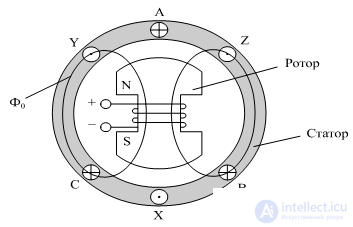
Pic 1
The windings of the generator AX, BY and CZ.
At power plants, a three-phase EMF system is formed at the terminals of a three-phase synchronous generator.
The generator consists of (Fig. 1):
1. Fixed stator with three windings.
2. Rotating rotor (electromagnet)
Between the stator and the rotor there is an air gap, from which the magnetic flux Fo is distributed according to a sinusoidal law along the circumference of Fig. 1.
The rotor electromagnet, excited by direct current, rotates under the action of a driving motor. 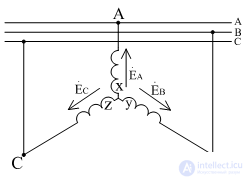
On the stator there is a winding consisting of three coils or phases, each of which is represented by a coil. The axes of the coils are shifted relative to each other by the same angle 2π / 3 relative to each other, i.e. at 120 °.
Beginning of the phases denote ABC, the ends of XYZ.
When the rotor rotates with a turbine, the magnetic field created by it excites sinus electromotive forces in the stationary stator windings with the same amplitude and frequency but shifted through an angle of 120 ° (2π / 3).
This system is symmetrical.
Image of 3-phase generator Fig 2 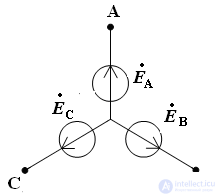
Pic 2
Trigonometric recording of phase emf: 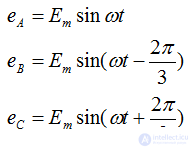
Complex effective values of EMF: 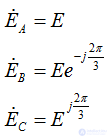
In switchgears, buses of different phases have different colors.
yellow - phase A
green - phase B
red - phase C  because the system is symmetrical
because the system is symmetrical
Vector diagram of a symmetric three-phase generator 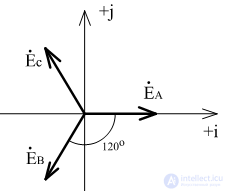
Comments
To leave a comment
Electrical Engineering, Circuit design
Terms: Electrical Engineering, Circuit design